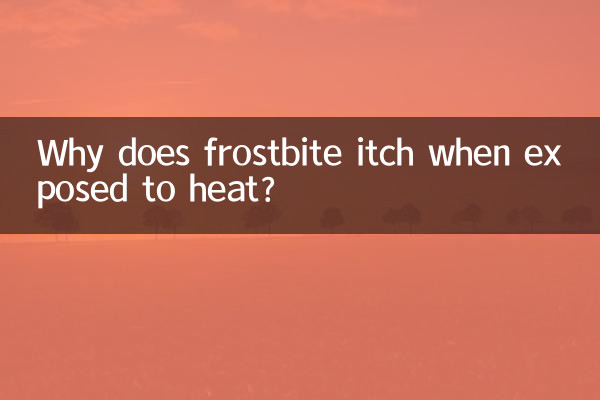Why does frostbite itch when exposed to heat?
Chilblains are a common skin disease in winter, especially in cold and humid environments. Many people find that during a frostbite attack they experience a noticeable itching sensation when the skin is heated. What are the scientific reasons behind this phenomenon? This article will give you a detailed analysis based on the hot topics and hot content on the Internet in the past 10 days.
1. The scientific reasons for chilblain and itching due to heat

The main reasons for chilblain and itching due to heat are related to blood circulation and nerve response. When the skin is cold, blood vessels constrict and blood flow is reduced, resulting in local tissue hypoxia. When the temperature rises, blood vessels suddenly expand and blood flows back into the ischemic area, stimulating nerve endings and causing itching.
In addition, tissue damage at the site of chilblains releases inflammatory mediators such as histamine, which can also stimulate nerve endings and aggravate itching.
2. Hot topics related to frostbite on the Internet in the past 10 days
| topic | heat index | Main discussion content |
|---|---|---|
| Quick method to relieve chilblain itching | 8.5 | Netizens share various anti-itch remedies, such as aloe vera gel, ginger juice, etc. |
| The relationship between chilblains and blood circulation | 7.2 | Medical experts explain the physiological mechanism of frostbite formation |
| winter skin care | 9.1 | Skin care experts recommend moisturizing products to prevent frostbite |
| Chilblain cream review | 6.8 | Consumers share their experiences using various frostbite creams |
3. How to relieve chilblain itching
1.progressive rewarming: Do not directly expose the chilblain area to high temperatures. Allow the skin to gradually adapt to temperature changes.
2.Use gentle moisturizing products: Choose alcohol-free moisturizer to help repair damaged skin barrier.
3.avoid scratching: Although the itching is unbearable, scratching can aggravate skin damage and prolong recovery time.
4.drug treatment: Use ointments containing hormones or antihistamines under the guidance of a doctor to reduce inflammation.
4. Suggestions for preventing chilblains
| Precautions | Effect evaluation | Things to note |
|---|---|---|
| Keep limbs warm and dry | ★★★★★ | Choose warm clothing that is breathable and sweat-absorbent |
| Proper exercise promotes blood circulation | ★★★★☆ | Avoid strenuous exercise in extremely cold weather |
| Balanced diet and nutritional supplements | ★★★☆☆ | Eat more foods rich in vitamin E |
| Use anti-chilblain products | ★★★☆☆ | Choose products produced by regular manufacturers |
5. Common misunderstandings about chilblain treatment
1.Mistake 1: Rubbing the frostbitten area with snow: This approach will aggravate tissue damage and gentle rewarming should be used.
2.Mistake 2: Soak in hot water immediately: Excessive temperature changes can cause excessive expansion of blood vessels and aggravate symptoms.
3.Mistake 3: Ignoring serious symptoms: If symptoms such as blisters and ulcers occur, seek medical attention promptly to avoid infection.
6. Expert opinions
According to recent medical reports, dermatologists remind: Although chilblains are common, if not treated promptly and correctly, they may lead to chronic skin problems. For recurrent chilblains, it is recommended to conduct a systemic examination to rule out underlying circulatory system diseases.
In addition, experts emphasize that prevention is better than cure. Protective measures should be taken before the cold season arrives, especially for children, the elderly and people with poor circulatory systems.
7. Conclusion
Chilblains and itching when exposed to heat are common physiological phenomena. Understanding the scientific principles behind them can help us take correct response measures. Through the structured data analysis of this article, we not only understand the causes of chilblain itching, but also master the scientific methods of prevention and treatment. Hopefully this information will help you have a comfortable and itch-free winter.

check the details

check the details